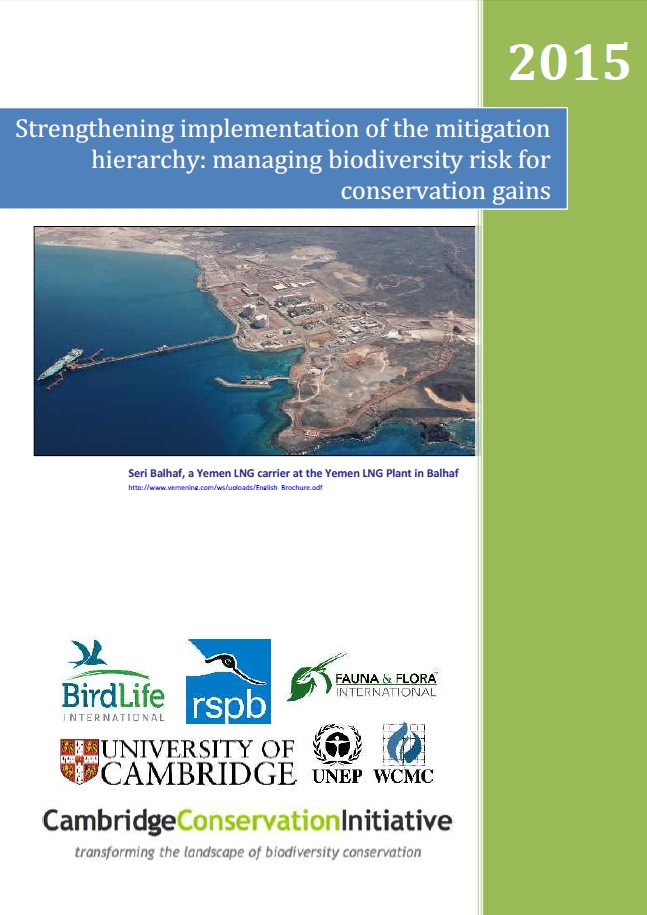 Thanks to Genevieve Hayes and Samir Whitaker from BirdLife for sharing their latest report on the mitigation hierarchy. Over a period of 9 months the team (BirdLife International, United Nations Environmental Programme – World Conservation Monitoring Centre (UNEP-WCMC), Royal Society for the Protection of Birds (RSPB), Fauna and Flora International (FFI) and the University of Cambridge) have worked on a CCI Collaborative Fund project titled ‘Strengthening implementation of the mitigation hierarchy: managing biodiversity risk for conservation gains’ – the aim and focus of the research has been on improving understanding and collating practical knowledge and experience on the Avoid stage of the mitigation hierarchy, to better inform how it should be ‘done’. The research stage of the project is now complete and the final report is available, based on which they will soon begin the next phase: engagement and support for the implementation and monitoring of the Avoid stage.
Thanks to Genevieve Hayes and Samir Whitaker from BirdLife for sharing their latest report on the mitigation hierarchy. Over a period of 9 months the team (BirdLife International, United Nations Environmental Programme – World Conservation Monitoring Centre (UNEP-WCMC), Royal Society for the Protection of Birds (RSPB), Fauna and Flora International (FFI) and the University of Cambridge) have worked on a CCI Collaborative Fund project titled ‘Strengthening implementation of the mitigation hierarchy: managing biodiversity risk for conservation gains’ – the aim and focus of the research has been on improving understanding and collating practical knowledge and experience on the Avoid stage of the mitigation hierarchy, to better inform how it should be ‘done’. The research stage of the project is now complete and the final report is available, based on which they will soon begin the next phase: engagement and support for the implementation and monitoring of the Avoid stage.
You can access the full report online and see the report overview and summary copied below.
Report overview
This report includes:
- A summary of legislative frameworks, International Finance Institution (IFI) standards and voluntary standards relevant to the avoidance stage of the mitigation hierarchy and collates examples of how different policies enable and/or impede effective implementation (Section 3).
- Case studies from mining, oil & gas, energy, infrastructure, housing, forestry and agriculture to illustrate different ways in which impacts have been avoided in practice (Section 4).
- Analysis of the barriers to widespread uptake and effective implementation of avoidance strategies to reduce biodiversity impacts (Section 5).
- Recommendations for Government, Corporate Sector, IFIs, and Non-Government Organisations (NGOs)/civil society to support the successful uptake and implementation of impact avoidance strategies and improve the application of the mitigation hierarchy (Section 6).
The findings of this report are based on a review of nine regional and national legislative frameworks and the analysis of 18 case studies selected from the recommendations of experts in the field. Discussions were also held with key individuals such as site level Environmental Managers, Project Engineers, as well as consultants, NGOs and individuals from IFIs (see Appendix (i) for more detail).
Summary
The scale and pace of development is intensifying across the mining, oil & gas, agriculture, infrastructure, forestry and housing sectors. Such rapid and large scale expansion in commercial development threatens to irreversibly transform landscapes around the world, putting pressure on biodiversity and the people that depend on it for their livelihoods and well-being.
Understanding the ecological and social impacts of proposed development and planning appropriate measures to mitigate those impacts wherever possible is critical. The mitigation hierarchy is a process that when used properly can ensure that development results in No Net Loss (NNL) of, or a Net Positive Impact (NPI) on biodiversity. It involves four key stages beginning with the avoidance of impacts. Where avoidance is not possible, the developer must seek to minimize impacts and restore areas. The last stage, and final resort, is to consider the potential to offset residual impacts. Given the inherent risks and uncertainty involved with offsetting, it should only ever be undertaken as a last resort, when harm to biodiversity cannot be avoided or mitigated. If it is not possible to avoid, minimize or adequately offset harm, the development should not proceed.
The first and arguably most important stage in the mitigation hierarchy — avoidance — requires that “measures [are] taken to anticipate and prevent adverse impacts on biodiversity before actions or decisions are taken that could lead to such impacts” (CSBI, 2015). Effective impact avoidance is vital to achieving NNL or NPI goals and reducing business risk. Yet in practice, impact avoidance is often overlooked, misunderstood and poorly applied. There is also a paucity of information available to support the design and implementation of effective avoidance strategies.This report has been brought together through the collaboration of BirdLife International, UNEP-WCMC, FFI, RSPB and the University of Cambridge in a project funded by the Cambridge Conservation Initiative. The purpose of the project is to strengthen the application of the mitigation hierarchy by promoting widespread and effective implementation of avoidance strategies in order to safeguard biodiversity and support NNL or NPI goals. Using 18 case studies and a regulatory review from 9 regions, the project analyses the drivers for impact avoidance, identifies practical examples of avoidance measures from a range of sectors and geographies, highlights potential barriers to the widespread adoption of effective impact avoidance and provides recommended actions to strengthen the application of the mitigation hierarchy and maximise impact avoidance potential.
